Overview
- Brief Narrative
- Scrip, valued at 50 kronen, distributed in Theresienstadt (Terezin) ghetto-labor camp. Currency was confiscated from inmates and replaced with scrip, which could only be used in the camp. The scrip was part of an elaborate illusion to make the camp seem normal and appear as though workers were being paid for their labor, but the money had no real monetary value. The scrip was printed by the National Bank in Prague in 7 denominations: 1, 2, 5, 10, 20, 50, and 100. The notes are dated 1 January 1943, but were not distributed until May 1943. Peter Kien, a Czechoslovakian poet, artist, and inmate of Theresienstadt designed the notes, but his original design was rejected by SS General Reinhard Heydrich. He was ordered to make Moses appear more stereotypically Semitic in appearance and to arrange Moses’s hand so that it is covering one of the commandments.
- Date
-
issue:
1943 January 01
- Geography
-
issue:
Theresienstadt (Concentration camp);
Terezin (Ustecky kraj, Czech Republic)
- Credit Line
- United States Holocaust Memorial Museum Collection, Gift of Tillman Neuner
- Markings
- face, center, printed, black and blue ink : QUITTUNG ÜBER / FÜNFZIG KRONEN / 50 / WER DIESE QUITTUNG VERFÄLSCHT ODER NACHMACHT / ODER GEFÄLSCHTE QUITTUNGEN IN VERKEHR BRINGT, / WIRD STRENGSTENS BESTRAFT. [Receipt / of / FIFTY CROWNS / 50 / ANYONE WHO FALSIFIES OR DISTORTS OR FAKES THIS RECEIPT, OR COUNTERFEITS RECEIPT, WILL BE STRICTLY PUNISHED]
face, lower right corner, printed, black ink : 50
reverse, upper left, serial number, printed, red ink : 004926
reverse, lower right, series letter, printed, red ink : D
reverse, upper right and lower left corners, printed, blue ink : 50
reverse, center, printed, black and blue ink : Quittung / über / FÜNFZIG KRONEN / THERESIENSTADT, AM 1.JÄNNER 1943 DER ALTESTE DER JUDEN / IN THERESIENSTADT / Jakob Edelstein [Receipt / of / FIFTY CROWNS / THERESIENSTADT, ON 1. JANUARY 1943 THE ELDER OF THE JEWS IN THERESIENSTADT / Jakob Edelstein] - Contributor
-
Designer:
Peter Kien
Printer: National Bank of Prague
Issuer: Der Alteste der Juden in Theresienstadt
- Biography
-
Franz Peter Kien was born January 1, 1919, in Varnsdorf, Czechoslovakia (Czech Republic), to Leonard and Olga Frankl Kien. His father Leonard was born in 1886, in Varnsdorf, and was a member of the German-speaking Jewish population in the, the Sudetenalnd, which bordered Germany. Leonard was a textile manufacturer with his own factory. Peter’s mother Olga was born in 1898, in Bzenec, Austro-Hungary (Czech Republic), to Jewish parents. After 1929, the Kien family moved to Brno. Peter enrolled at the German Gymnasium, where he excelled at drawing, painting, and writing. In 1936, he graduated and moved to Prague to study at the Academy of Fine Arts. He also attended the Officina Pragensis, a private graphic design school run by a well-known Jewish artist, Hugo Steiner-Prag.
On September 29, 1938, Germany annexed the Sudetenland. On March 15, 1939, Germany invaded Prague and annexed the Bohemia and Moravia provinces of Czechoslovakia, ruled by a Reich Protector. Jews were banned from participation in government, businesses, and organization, including schools. Peter had to leave the Academy, but continued to study at the Officina Pragensis. He also taught at Vinohrady Synagogue. In September 1940, Peter married Ilse Stranska, who was born on May 9, 1915, in Pilsen, to Jewish parents.
In late September 1941, Reinhard Heydrich, the SS head of RSHA, Reich Main Security Office, became Reich Protector. Soon there were regular deportations of Jews to concentration camps. At the end of November, Theresienstadt concentration and transit camp near Prague got its first shipment of Jewish prisoners. On December 14, Peter was transported to Theresienstadt ghetto-labor camp. He was assigned to the technical department where he worked as a draftsman and designer alongside other artists, including Bedrich Fritta, Leo Haas, and Jiri Lauscher. On July 16, 1942, Peter’s wife Ilse arrived in the camp. On January 30, 1943, Peter’s parents Leonard and Olga were transported from Bzenec to Terezin. Peter was assigned major projects by the Jewish Council that administered the camp for the Germans, such as the scrip receipts used in place of money in the camp. He secretly documented the inmate’s daily life, creating portraits and other drawings, and wrote plays, poems, and an operatic libretto. On October 16, 1944, Peter’s wife Ilse and his parents Leonard and Olga were selected for deportation. Peter volunteered to go with them. Before leaving, Peter and his family were sent to Auschwitz concentration camp in German-occupied Poland. Peter survived the selection process, soon fell ill, likely with typhus, and died at age 25 in late October 1944. His wife and parents were killed at Auschwitz. Some of the work that Peter left with other prisoners or hid at Theresienstadt survived and has been exhibited worldwide.
Physical Details
- Language
- German
- Classification
-
Exchange Media
- Category
-
Money
- Object Type
-
Scrip (aat)
- Genre/Form
- Money.
- Physical Description
- Theresienstadt scrip printed on rectangular, off-white paper in blue and black ink. The paper contains a watermark in the form of a repeating geometric pattern. On the face is a rectangle with geometric patterning and a wide, off-white margin to the right. On the left, within the rectangle, is a vignette with an image of Moses holding 2 stone tablets inscribed with the 10 Commandments in Hebrew. To his right, is the denomination centered between lines of German text. In the lower right corner is a Star of David with the denomination below. The reverse has a rectangle with geometric patterning and a wide, off-white margin to the left. Within the rectangle is a central brown streak, medallion, German text above and below a scrollwork line, the denomination on the upper right, and signature on the lower right. In the lower left corner is the denomination below a Star of David in a striped circle. The serial number in the upper left corner and the series letter on the lower right are both in red ink.
- Dimensions
- overall: Height: 2.750 inches (6.985 cm) | Width: 5.500 inches (13.97 cm)
- Materials
- overall : paper, ink
Rights & Restrictions
- Conditions on Access
- No restrictions on access
- Conditions on Use
- No restrictions on use
Keywords & Subjects
Administrative Notes
- Legal Status
- Permanent Collection
- Provenance
- The scrip was donated to the United States Holocaust Memorial Museum in 1999 by Tillman Neuner.
- Record last modified:
- 2024-07-16 15:35:55
- This page:
- https://collections.ushmm.org/search/catalog/irn594907
Download & Licensing
In-Person Research
- By Appointment
- Request 21 Days in Advance of Visit
- Plan a Research Visit
- Request to See This Object
Contact Us
Also in Tillman Neuner collection
The collection contains 14 pieces of scrip and a stamp from Theresienstadt.
Date: 1943 January 01-1945 May
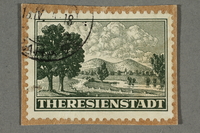
canceled parcel admission stamp for Theresienstadt ghetto-labor camp
Object
Parcel admission stamp for Theresienstadt ghetto-labor camp, depicting the surrounding landscape of Bohemia. The camp was established by the Germans in November 1941 about 40 miles north of Prague in the Protectorate of Bohemia and Moravia created after Nazi Germany occupied the western region of Czechoslovakia in March 1939. It was a multi-use camp, acting as a settlement, transit camp, and propaganda tool. The stamp, which was printed in Prague, was issued by the Prague Jewish Council beginning in July 1943. Inmates at Theresienstadt could receive inspected packages of food and clothing from people outside the camp if the packages had this stamp. An inmate could request a package every two months. The Jewish Council in Prague would notify the sender to come pick up the stamp if they lived in Prague; if they lived outside of Prague, the stamp would be attached to the notice. Living conditions in the camp were horrible and about 33,000 inmates died there. On May 2, 1945, as the end of the war approached, the International Red Cross took over administration of the camp. The German staff fled on May 5 and 6, and on May 9, Soviet troops arrived and assumed responsibility.
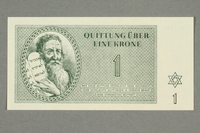
Theresienstadt ghetto-labor camp scrip, 1 krone note
Object
Scrip, valued at 1 krone, distributed in Theresienstadt (Terezin) ghetto-labor camp. Currency was confiscated from inmates and replaced with scrip, which could only be used in the camp. The scrip was part of an elaborate illusion to make the camp seem normal and appear as though workers were being paid for their labor, but the money had no real monetary value. The scrip was printed by the National Bank in Prague in 7 denominations: 1, 2, 5, 10, 20, 50, and 100. The notes are dated 1 January 1943, but were not distributed until May 1943. Peter Kien, a Czechoslovakian poet, artist, and inmate of Theresienstadt designed the notes, but his original design was rejected by SS General Reinhard Heydrich. He was ordered to make Moses appear more stereotypically Semitic in appearance and to arrange Moses’s hand so that it is covering one of the commandments.
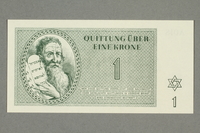
Theresienstadt ghetto-labor camp scrip, 1 krone note
Object
Scrip, valued at 1 krone, distributed in Theresienstadt (Terezin) ghetto-labor camp. Currency was confiscated from inmates and replaced with scrip, which could only be used in the camp. The scrip was part of an elaborate illusion to make the camp seem normal and appear as though workers were being paid for their labor, but the money had no real monetary value. The scrip was printed by the National Bank in Prague in 7 denominations: 1, 2, 5, 10, 20, 50, and 100. The notes are dated 1 January 1943, but were not distributed until May 1943. Peter Kien, a Czechoslovakian poet, artist, and inmate of Theresienstadt designed the notes, but his original design was rejected by SS General Reinhard Heydrich. He was ordered to make Moses appear more stereotypically Semitic in appearance and to arrange Moses’s hand so that it is covering one of the commandments.
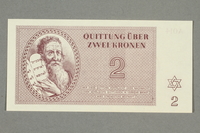
Theresienstadt ghetto-labor camp scrip, 2 kronen note
Object
Scrip, valued at 2 kronen, distributed in Theresienstadt (Terezin) ghetto-labor camp. Currency was confiscated from inmates and replaced with scrip, which could only be used in the camp. The scrip was part of an elaborate illusion to make the camp seem normal and appear as though workers were being paid for their labor, but the money had no real monetary value. The scrip was printed by the National Bank in Prague in 7 denominations: 1, 2, 5, 10, 20, 50, and 100. The notes are dated 1 January 1943, but were not distributed until May 1943. Peter Kien, a Czechoslovakian poet, artist, and inmate of Theresienstadt designed the notes, but his original design was rejected by SS General Reinhard Heydrich. He was ordered to make Moses appear more stereotypically Semitic in appearance and to arrange Moses’s hand so that it is covering one of the commandments.
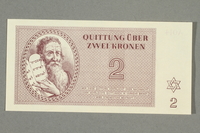
Theresienstadt ghetto-labor camp scrip, 2 kronen note
Object
Scrip, valued at 2 kronen, distributed in Theresienstadt (Terezin) ghetto-labor camp. Currency was confiscated from inmates and replaced with scrip, which could only be used in the camp. The scrip was part of an elaborate illusion to make the camp seem normal and appear as though workers were being paid for their labor, but the money had no real monetary value. The scrip was printed by the National Bank in Prague in 7 denominations: 1, 2, 5, 10, 20, 50, and 100. The notes are dated 1 January 1943, but were not distributed until May 1943. Peter Kien, a Czechoslovakian poet, artist, and inmate of Theresienstadt designed the notes, but his original design was rejected by SS General Reinhard Heydrich. He was ordered to make Moses appear more stereotypically Semitic in appearance and to arrange Moses’s hand so that it is covering one of the commandments.
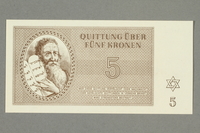
Theresienstadt ghetto-labor camp scrip, 5 kronen note
Object
Scrip, valued at 5 kronen, distributed in Theresienstadt (Terezin) ghetto-labor camp. Currency was confiscated from inmates and replaced with scrip, which could only be used in the camp. The scrip was part of an elaborate illusion to make the camp seem normal and appear as though workers were being paid for their labor, but the money had no real monetary value. The scrip was printed by the National Bank in Prague in 7 denominations: 1, 2, 5, 10, 20, 50, and 100. The notes are dated 1 January 1943, but were not distributed until May 1943. Peter Kien, a Czechoslovakian poet, artist, and inmate of Theresienstadt designed the notes, but his original design was rejected by SS General Reinhard Heydrich. He was ordered to make Moses appear more stereotypically Semitic in appearance and to arrange Moses’s hand so that it is covering one of the commandments.
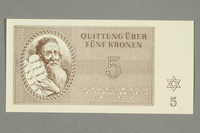
Theresienstadt ghetto-labor camp scrip, 5 kronen note
Object
Scrip, valued at 5 kronen, distributed in Theresienstadt (Terezin) ghetto-labor camp. Currency was confiscated from inmates and replaced with scrip, which could only be used in the camp. The scrip was part of an elaborate illusion to make the camp seem normal and appear as though workers were being paid for their labor, but the money had no real monetary value. The scrip was printed by the National Bank in Prague in 7 denominations: 1, 2, 5, 10, 20, 50, and 100. The notes are dated 1 January 1943, but were not distributed until May 1943. Peter Kien, a Czechoslovakian poet, artist, and inmate of Theresienstadt designed the notes, but his original design was rejected by SS General Reinhard Heydrich. He was ordered to make Moses appear more stereotypically Semitic in appearance and to arrange Moses’s hand so that it is covering one of the commandments.
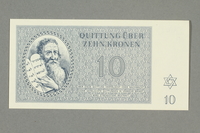
Theresienstadt ghetto-labor camp scrip, 10 kronen note
Object
Scrip, valued at 10 kronen, distributed in Theresienstadt (Terezin) ghetto-labor camp. Currency was confiscated from inmates and replaced with scrip, which could only be used in the camp. The scrip was part of an elaborate illusion to make the camp seem normal and appear as though workers were being paid for their labor, but the money had no real monetary value. The scrip was printed by the National Bank in Prague in 7 denominations: 1, 2, 5, 10, 20, 50, and 100. The notes are dated 1 January 1943, but were not distributed until May 1943. Peter Kien, a Czechoslovakian poet, artist, and inmate of Theresienstadt designed the notes, but his original design was rejected by SS General Reinhard Heydrich. He was ordered to make Moses appear more stereotypically Semitic in appearance and to arrange Moses’s hand so that it is covering one of the commandments.
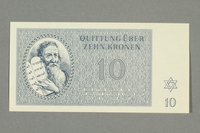
Theresienstadt ghetto-labor camp scrip, 10 kronen note
Object
Scrip, valued at 10 kronen, distributed in Theresienstadt (Terezin) ghetto-labor camp. Currency was confiscated from inmates and replaced with scrip, which could only be used in the camp. The scrip was part of an elaborate illusion to make the camp seem normal and appear as though workers were being paid for their labor, but the money had no real monetary value. The scrip was printed by the National Bank in Prague in 7 denominations: 1, 2, 5, 10, 20, 50, and 100. The notes are dated 1 January 1943, but were not distributed until May 1943. Peter Kien, a Czechoslovakian poet, artist, and inmate of Theresienstadt designed the notes, but his original design was rejected by SS General Reinhard Heydrich. He was ordered to make Moses appear more stereotypically Semitic in appearance and to arrange Moses’s hand so that it is covering one of the commandments.
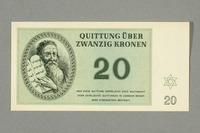
Theresienstadt ghetto-labor camp scrip, 20 kronen note
Object
Scrip, valued at 20 kronen, distributed in Theresienstadt (Terezin) ghetto-labor camp. Currency was confiscated from inmates and replaced with scrip, which could only be used in the camp. The scrip was part of an elaborate illusion to make the camp seem normal and appear as though workers were being paid for their labor, but the money had no real monetary value. The scrip was printed by the National Bank in Prague in 7 denominations: 1, 2, 5, 10, 20, 50, and 100. The notes are dated 1 January 1943, but were not distributed until May 1943. Peter Kien, a Czechoslovakian poet, artist, and inmate of Theresienstadt designed the notes, but his original design was rejected by SS General Reinhard Heydrich. He was ordered to make Moses appear more stereotypically Semitic in appearance and to arrange Moses’s hand so that it is covering one of the commandments.
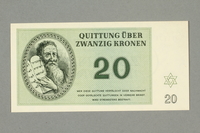
Theresienstadt ghetto-labor camp scrip, 20 kronen note
Object
Scrip, valued at 20 kronen, distributed in Theresienstadt (Terezin) ghetto-labor camp. Currency was confiscated from inmates and replaced with scrip, which could only be used in the camp. The scrip was part of an elaborate illusion to make the camp seem normal and appear as though workers were being paid for their labor, but the money had no real monetary value. The scrip was printed by the National Bank in Prague in 7 denominations: 1, 2, 5, 10, 20, 50, and 100. The notes are dated 1 January 1943, but were not distributed until May 1943. Peter Kien, a Czechoslovakian poet, artist, and inmate of Theresienstadt designed the notes, but his original design was rejected by SS General Reinhard Heydrich. He was ordered to make Moses appear more stereotypically Semitic in appearance and to arrange Moses’s hand so that it is covering one of the commandments.
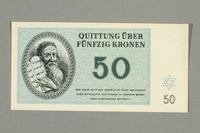
Theresienstadt ghetto-labor camp scrip, 50 kronen note
Object
Scrip, valued at 50 kronen, distributed in Theresienstadt (Terezin) ghetto-labor camp. Currency was confiscated from inmates and replaced with scrip, which could only be used in the camp. The scrip was part of an elaborate illusion to make the camp seem normal and appear as though workers were being paid for their labor, but the money had no real monetary value. The scrip was printed by the National Bank in Prague in 7 denominations: 1, 2, 5, 10, 20, 50, and 100. The notes are dated 1 January 1943, but were not distributed until May 1943. Peter Kien, a Czechoslovakian poet, artist, and inmate of Theresienstadt designed the notes, but his original design was rejected by SS General Reinhard Heydrich. He was ordered to make Moses appear more stereotypically Semitic in appearance and to arrange Moses’s hand so that it is covering one of the commandments.
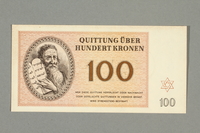
Theresienstadt ghetto-labor camp scrip, 100 kronen note
Object
Scrip, valued at 100 kronen, distributed in Theresienstadt (Terezin) ghetto-labor camp. Currency was confiscated from inmates and replaced with scrip, which could only be used in the camp. The scrip was part of an elaborate illusion to make the camp seem normal and appear as though workers were being paid for their labor, but the money had no real monetary value. The scrip was printed by the National Bank in Prague in 7 denominations: 1, 2, 5, 10, 20, 50, and 100. The notes are dated 1 January 1943, but were not distributed until May 1943. Peter Kien, a Czechoslovakian poet, artist, and inmate of Theresienstadt designed the notes, but his original design was rejected by SS General Reinhard Heydrich. He was ordered to make Moses appear more stereotypically Semitic in appearance and to arrange Moses’s hand so that it is covering one of the commandments.
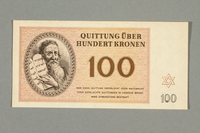
Theresienstadt ghetto-labor camp scrip, 100 kronen note
Object
Scrip, valued at 100 kronen, distributed in Theresienstadt (Terezin) ghetto-labor camp. Currency was confiscated from inmates and replaced with scrip, which could only be used in the camp. The scrip was part of an elaborate illusion to make the camp seem normal and appear as though workers were being paid for their labor, but the money had no real monetary value. The scrip was printed by the National Bank in Prague in 7 denominations: 1, 2, 5, 10, 20, 50, and 100. The notes are dated 1 January 1943, but were not distributed until May 1943. Peter Kien, a Czechoslovakian poet, artist, and inmate of Theresienstadt designed the notes, but his original design was rejected by SS General Reinhard Heydrich. He was ordered to make Moses appear more stereotypically Semitic in appearance and to arrange Moses’s hand so that it is covering one of the commandments.



